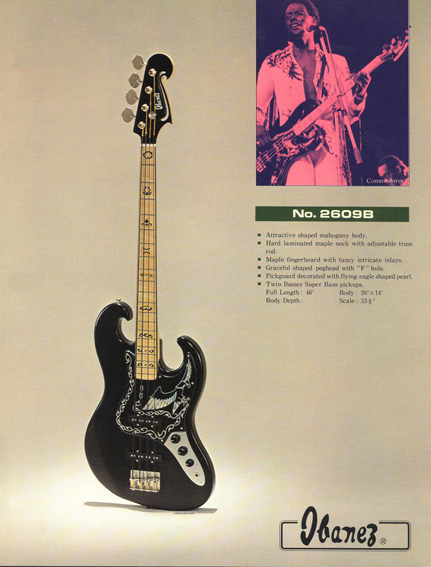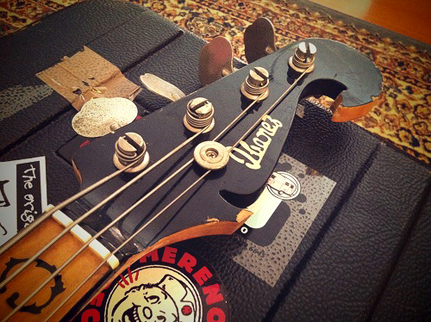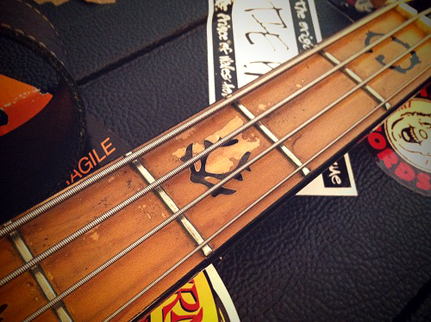1977 Ibanez Black Eagle Bass

My best sounding bass… aka The Black Macaw.
In most of my posts regarding my basses, I’ve talked about the Ibanez Black Eagle bass I bought to replace my broken Tym T-Byrd so I thought the time has finally come to share the story of this beast with you.
The story starts (AGAIN) with my favourite band, Rocket From The Crypt. I’d been obsessing over them since my friend Dan put me on to them, and listened to them (and the Hot Snakes) non stop from 2003 to 2009… pretty much. I always loved Petey X’s bass sound, especially in the song ‘Hot Charity’. Doing a bit of research, I found out he played an Ibanez Black Eagle bass pretty much exclusively throughout his whole time with RFTC.

I loved the look of them. They were kind of Las Vegas… but sinister as well. The main endorsee when they were released were the Commodores, which explains the whole Vegas thing. In that context, the scroll horns and pearloid scratch plate makes a bit more sense.

Another famous user was Krist Novoselic from Nirvana. He used them from their early days up until swapping it for a Gibson Moderne & Grabber later on. Listen to the intro of ‘Blew’ and you’ll see how cool these basses sound.

This research of a particular instrument usually has a typical reaction to me… I become obsessed by them and NEEEEEEED to own one. And so it was with the Black Eagle. I didn’t care that they were made of mahogany and apparently weighed as much as two Les Pauls strapped together… I NEEEEEEEDED to own one. I didn’t care that they were rare and pretty much non-existant. When has that stopped me before? I’ll tell you when. Never. That’s when. This blog would have about 3 stories if I gave up every time it was ‘impossible’ to own what I wanted.
As what usually happens in cases like this, I search furiously for instruments like this, give up and then one turns up 2 months later. And that’s what happened here. I walked into Tym’s one afternoon and there it was hanging on the wall. A trickle of sweat ran down my forehead as I reached for it. I was surprised that it was a featherweight. I’d heard stories of peoples collar bones bending under the sheer weight of these things. This one was the perfect weight for a tiny boy man like me.

It’d been well played and had been through the wars a bit. The headstock had snapped off where the routing was… a common fault with this model. That’s why I call this bass the Black Macaw, as the headstock looks like a parrots beak now.

The fretboard’s finish had reacted weirdly and turned brown. This didn’t worry me… I like my instruments crusty.

It played beautiful, looked beautiful and came in the original hard case. At the time, I was very disillusioned with my Maton Phil Manning Custom Stereo as it didn’t sound like my Les Paul so I asked Tim if we could do a trade for them. Tim agreed and it was mine. I then proceeded to play the crap out of her for the next couple of years…

It sounds HUUUGE. Like the perfect mix between a Jazz Bass and a P-Bass. The punch of the P-Bass and the warmth of the Jazz. I’m not exactly sure what wood it is made of. It’s supposed to be mahogany, but this bass is way lighter than any I’ve heard of. Also, there’s a patch of paint missing on the back which shows some grain. To me it looks like ash or alder, but I’m no wood expert. If it’s not mahogany, it might’ve been a special order for someone…

I used it to record what I consider is the best recording I’ve ever been part of… the Sixfthick ‘Bite Marks/Glue In Your Locks’ 7″. It is easily the best sounding bass I own. Everyone who has heard it has said so.
After 2 years of hard playing, the paint was starting to disintegrate. It’s almost like a brittle toffee. You can see the strum marks on the front. I felt terrible.

As by now my Tym T-Byrd was back in action, I retired Black Macaw to recording duties. I want it to last for the rest of my bass playing days, so it stays at home now.I might pull her out for a special occasion in the future, though.
On the other end of the Black Eagle spectrum… far away from my beaten up example is this near mint Black Eagle owned by a friend of a friend since new. It’s in amazing condition, with only slight pitting on the chrome control panel & bridge.

The headstock is still in one piece. You can see why so many of these have snapped like mine… there’s not much wood there, so the slightest bump against a cymbal stand and ‘crack’. My friend Tim said he can fix mine up for me one day if I want…

The great thing about this bass is the original strap. I’m not sure if this is a legitimate Ibanez Black Eagle strap, but it looks the part.


A little while ago on the Ibanez Collectors forum, the prototype for the Black Eagle Bass turned up. It appears to be based on Ibanez’s standard Jazz Bass, but with many of the Black Eagle appointments. It’s a great insight into how Ibanez developed one of their iconic instruments.

Here is the info on this bass from Nick of blackeaglebass.com
This guitar is the prototype for the Black Eagle, I put the owner in touch with the CEO of Fujigen and he managed to find Mr Hirabayashi who assembled this guitar in June 1974, and he (Mr Hirabayashi) confirmed that this is the prototype.
We can now say that the Black eagle started with : A body and neck from their Jazz Bass copy (model 2365B). The prototype neck was inlaid with pearloid (not black celluloid as is the case with the production guitar) in the same pattern as per their Banjo (produced 1973-77), which was is itself a copy of the Gibson 5 string Mastertone Banjo of the 1930/40s.

The Jazz body was fitted with the distinctive Eagle pickguard. The scrolls were engraved on the top and painted in white, on the underside of the pickguard, the Eagle was screen printed in black and white leaving the wing areas clear, they then applied very thin sheets of abalone shell giving the distinctive appearance of the Black Eagle pickguard. As they finalised the design, they created their own neck with the cut-out in the headstock, inlaid the Maple fretboard in the same banjo pattern, but now in black celluloid, which matched the fret board binding, then added a new body, which is a copy or heavily influenced by the Burns guitars of the early 1960s.

The very early Black Eagles had a black truss rod cover, which was phased out well before the end of the production.

Anyway, here’s me with my Black Eagle in my band Sixfthick, mashed up with Nation Blue… to make 6FtNation, playing a Hot Snakes song.
•edit: Here’s a weird bass I found on a japanese auction site which has the Black Eagle’s neck inlays. Looks to be a rare Greco… never see on one before. The headstock is the same as the Ibanez Bob Weir models. I like it.



***update: An amazing, rare white Antoria Black Eagle (White Eagle) bass has just come up on the UK eBay, sold by the current bassist of Slade. I never knew these existed… I know the Antoria models are the siamese twins of Ibanez, being made in the same factory. I would love this… LOVE.THIS.


I thought it might’ve been a respray, but the headstock still has the original Antoria logo on it. It certainly changes the overall look of the bass… doesn’t look so sinister now. It’s definitely a lot more glam/vegas.


this is my holy grail at the moment, the bassist from part chimp uses one these days, it’s the only one i’ve seen in the flesh.